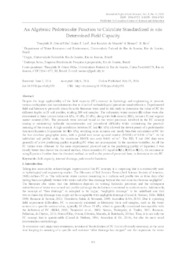An algebraic pedotransfer function to calculate standardized in situ determined field capacity.
An algebraic pedotransfer function to calculate standardized in situ determined field capacity.
Author(s): OTTONI FILHO, T. B.; LEAL, I. F.; MACEDO, J. R. de; REIS, B. C. B.
Summary: Despite the large applicability of the field capacity (FC) concept in hydrology and engineering, it presents various ambiguities and inconsistencies due to a lack of methodological procedure standardization. Experimental field and laboratory protocols taken from the literature were used in this study to determine the value of FC for different depths in 29 soil profiles, totaling 209 soil samples. The volumetric water content (θ) values were also determined at three suction values (6 kPa, 10 kPa, 33 kPa), along with bulk density (BD), texture (T) and organic matter content (OM). The protocols were devised based on the water processes involved in the FC concept aiming at minimizing hydraulic inconsistencies and procedural difficulty while maintaining the practical meaning of the concept. A high correlation between FC and θ(6 kPa) allowed the development of a pedotransfer function (Equation 3) quadratic for θ(6 kPa), resulting in an accurate and nearly bias-free calculation of FC for the four database geographic areas, with a global root mean squared residue (RMSR) of 0.026 m3·m-3. At the individual soil profile scale, the maximum RMSR was only 0.040 m3·m-3. The BD, T and OM data were generally of a low predicting quality regarding FC when not accompanied by the moisture variables. As all the FC values were obtained by the same experimental protocol and as the predicting quality of Equation 3 was clearly better than that of the classical method, which considers FC equal to θ(6), θ(10) or θ(33), we recommend using Equation 3 rather than the classical method, as well as the protocol presented here, to determine in-situ FC.
Publication year: 2016
Types of publication: Journal article
Unit: Embrapa Soils
Observation
Some of Embrapa's publications are published as ePub files. To read them, use or download one of the following free software options to your computer or mobile device. Android: Google Play Books; IOS: iBooks; Windows and Linux: Calibre.
Access other publications
Access the Agricultural Research Database (BDPA) to consult Embrapa's full library collection and records.
Visit Embrapa Bookstore to purchase books and other publications sold by Embrapa.

